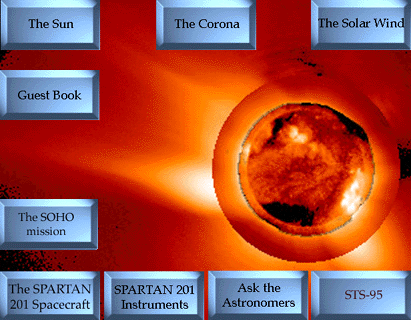
SPARTAN 201: NASA's mission to explore the Sun's corona
A composite image of the solar corona on 1993 April 11 from SPARTAN 201-1
White Light Coronagraph (outermost), the High Altitude Observatory Mk. III
coronagraph on Mauna Loa, Hawaii (middle), and the Yohkoh
Soft X-Ray Telescope (innermost image)
Press any button for more information.
These pages include images downlinked in near realtime
from the white light coronagraph, as part of the
technology demonstration of SPARTAN realtime telemetry.
![[SPARTAN 201 decal]](images/SPARTAN_decal_tn.gif)
| ![[SPARTAN 201-4 dgrappled]](images/grapple.gif)
|
| SPARTAN 201-4 grappled by STS-87 astronauts
|
The United States Space Shuttle
Columbia (OV-102) was not able to deploy
SPARTAN 201-04, a small shuttle-launched and -retrieved satellite, whose
mission is to study the origins of the solar wind, on 1997 November 21 during
Shuttle mission STS-87.
The two instruments of SPARTAN 201, the
Ultraviolet Coronal Spectrometer and the
White Light Coronagraph.
SPARTAN 201 has flown on three previous missions:
- SPARTAN 201-1 on Mission
STS-56 (1993 April)
- SPARTAN 201-2 on Mission
STS-64 (1994 September)
- SPARTAN 201-3 on Mission
STS-69 (1995 September)
The 1994 September observations were coordinated with observations made by the
Ulysses spacecraft and
other space- and ground-based observatories. The SPARTAN 201-4 flight will be
coordinated with observations made from the
Solar and Heliospheric Observatory
(SOHO) , a mission of international cooperation between the
European Space Agency (ESA) and NASA. In particular, the SPARTAN
UVCS will be used to
determine the instrumental profile of the H I Lyman alpha line for the
SOHO UVCS.
This work will require relatively long periods with fixed pointing, during
which the SPARTAN
White Light Coronagraph and the SOHO
LASCO coronagraphs will
search for short time-scale variability in electron-scattering corona.
If your Web viewer isn't imagemap-capable, here are links to more
material:
Related information:
Text provided by Dr. Madhulika Guhathakurta of NASA Headquarters and Dr. Joseph B. Gurman, NASA Goddard Space Flight Center.


![[SPARTAN 201 decal]](images/SPARTAN_decal_tn.gif)
![[SPARTAN 201-4 dgrappled]](images/grapple.gif)